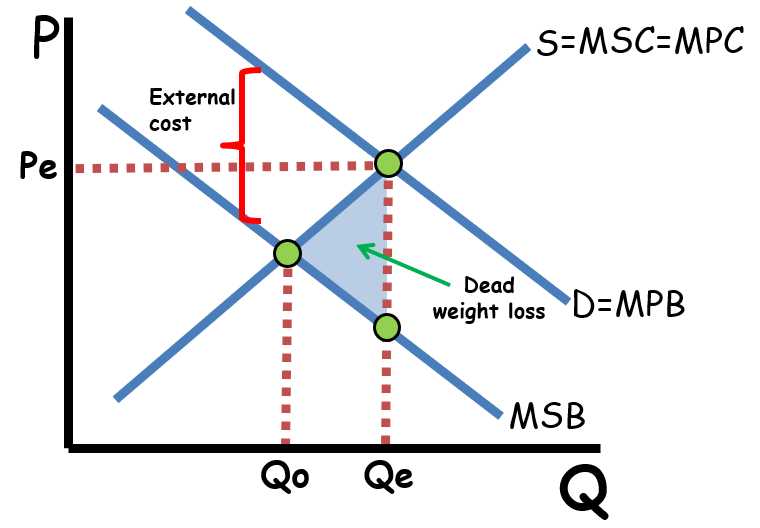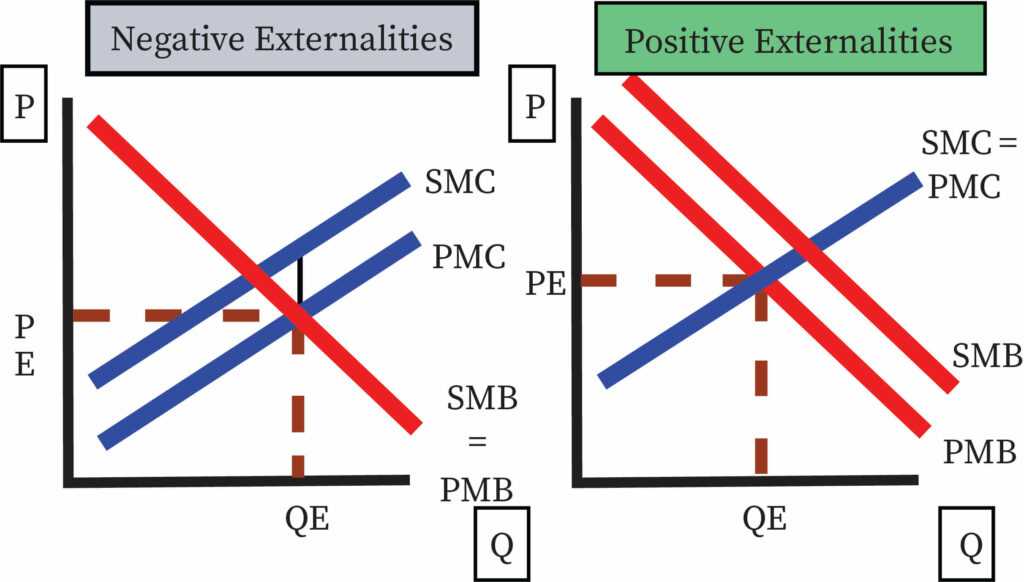What is Externality?
Externality is a concept in economics that refers to the impact of an economic activity on a third party who is not directly involved in the transaction. It occurs when the actions of one party have either positive or negative effects on others, without any compensation being provided.
There are two types of externalities: positive externality and negative externality. A positive externality occurs when an economic activity generates benefits for others, while a negative externality occurs when an economic activity imposes costs on others.
For example, if a factory installs pollution control equipment to reduce emissions, it not only benefits the factory itself by improving air quality, but also benefits the surrounding community by reducing pollution-related health problems. This is an example of a positive externality.
On the other hand, if a factory releases pollutants into the air, it not only imposes costs on the factory itself in terms of potential fines and legal liabilities, but also imposes costs on the surrounding community in terms of health problems and reduced property values. This is an example of a negative externality.
Externalities can have significant implications for economic efficiency and social welfare. They can lead to overproduction or underproduction of goods and services, as well as misallocation of resources. Therefore, it is important for policymakers and economists to understand and address externalities in order to promote a more efficient and equitable allocation of resources.
Definition and Explanation
An externality is a concept in economics that refers to the impact of a transaction or activity on a third party who is not directly involved in the transaction. It occurs when the actions of one economic agent affect the well-being of another agent, without any compensation or payment being made. Externalities can be positive or negative, depending on whether they result in a benefit or a cost to the third party.
Externalities can arise in various economic activities, such as production, consumption, or even the use of public goods. They can have both direct and indirect effects on individuals, businesses, and society as a whole.
To better understand externalities, economists often use the concept of social costs and benefits. Social costs include both private costs (borne by the economic agents directly involved in the transaction) and external costs (borne by third parties). Similarly, social benefits include both private benefits and external benefits. Externalities can lead to a divergence between private and social costs or benefits, which can result in market inefficiencies and the need for government intervention.
Types of Externality

In economics, externality refers to the impact of a transaction or activity on a third party who is not directly involved in the transaction. These external effects can be positive or negative, and they can occur in various forms. Here are the different types of externality:
1. Production Externality
A production externality occurs when the production of a good or service affects the well-being of individuals or firms who are not directly involved in the production process. This can result in either positive or negative externalities.
For example, a factory that emits pollution into the air imposes a negative production externality on the surrounding community. The pollution can harm the health of the residents and damage the environment. On the other hand, if a company invests in research and development to improve its production process, it can lead to positive production externalities by creating new technologies or knowledge that can benefit other firms or industries.
2. Consumption Externality
A consumption externality occurs when the consumption of a good or service by one individual affects the well-being of others who are not directly involved in the consumption. Similar to production externalities, consumption externalities can be positive or negative.
For instance, smoking in public places creates a negative consumption externality as it exposes non-smokers to secondhand smoke, which can harm their health. On the other hand, education is considered a positive consumption externality because an educated individual can bring benefits to society as a whole by contributing to economic growth, innovation, and social progress.
3. Network Externality
A network externality occurs when the value of a good or service increases as more people use it. This can be seen in industries such as telecommunications, social media, and software. The more people who use a particular phone network or social media platform, the more valuable it becomes for each user.
For example, in the case of social media platforms like Facebook or Instagram, the more users there are, the more content is available for users to interact with, making the platform more attractive and valuable. This positive network externality can lead to a network effect, where the popularity of a product or service grows exponentially as more people join.
4. Knowledge Externality
A knowledge externality occurs when the knowledge or information generated by an individual or firm spills over to benefit others. This can happen through research and development, innovation, or even informal knowledge sharing.
For instance, when a pharmaceutical company develops a new drug, the knowledge gained from the research can benefit other companies in the industry, leading to advancements in medical treatments. Similarly, open-source software projects, where developers freely share their code, create positive knowledge externalities by allowing others to build upon and improve the software.
Positive Externality Examples
A positive externality occurs when the production or consumption of a good or service benefits a third party who is not directly involved in the transaction. In other words, it is a positive spillover effect that creates benefits for individuals or society as a whole.
Here are some examples of positive externalities:
1. Vaccinations: When individuals receive vaccinations, they not only protect themselves from diseases but also contribute to the overall health of the community. By getting vaccinated, individuals reduce the risk of spreading diseases to others who may not be able to get vaccinated, such as infants or individuals with weakened immune systems.
2. Education: When individuals receive education, it not only benefits them personally but also benefits society as a whole. Educated individuals are more likely to find better job opportunities, earn higher incomes, and contribute to economic growth. Additionally, an educated population can lead to a more informed and engaged citizenry, which is essential for a functioning democracy.
3. Research and Development: When companies invest in research and development (R&D), they often create new technologies or innovations that have positive spillover effects on other firms and industries. For example, advancements in technology can lead to increased productivity, lower costs, and improved products, benefiting both the company conducting the R&D and other businesses that can adopt or adapt the new technologies.
4. Environmental Conservation: When individuals or organizations engage in activities that promote environmental conservation, such as recycling or reducing carbon emissions, they create positive externalities by improving the quality of the environment for everyone. These actions can lead to cleaner air and water, preservation of natural resources, and protection of biodiversity.
5. Public Goods: Public goods, such as parks, libraries, and public transportation systems, provide benefits to the entire community. Even if individuals do not directly use or pay for these goods, they can still enjoy the benefits they provide. For example, a well-maintained park not only provides recreational opportunities for individuals but also enhances the overall quality of life in the community.
Negative Externality Examples

A negative externality occurs when the production or consumption of a good or service imposes costs on third parties who are not involved in the transaction. These costs can be in the form of pollution, health hazards, or other negative impacts on society. Here are some examples of negative externalities:
1. Air Pollution from Industrial Activities

Many industrial activities, such as manufacturing and power generation, release pollutants into the air. These pollutants can have harmful effects on the environment and human health. For example, emissions from factories can contribute to smog, acid rain, and respiratory diseases.
2. Noise Pollution from Construction Sites
Construction sites often generate high levels of noise, which can be disruptive to nearby residents and businesses. The noise pollution can affect people’s quality of life, disturb sleep patterns, and even lead to stress-related health issues.
3. Second-Hand Smoke from Smoking

When people smoke in public places, they expose others to second-hand smoke, which contains harmful chemicals. Non-smokers who inhale second-hand smoke can experience various health problems, including respiratory issues, heart disease, and lung cancer.
4. Traffic Congestion
Increased traffic on roads can lead to congestion, causing delays and frustration for drivers. It also results in increased fuel consumption and air pollution. The negative effects of traffic congestion extend beyond the individual drivers to the community as a whole.
5. Deforestation
Deforestation, often driven by agricultural activities and logging, has significant negative externalities. It contributes to climate change, loss of biodiversity, soil erosion, and disruption of local ecosystems. These impacts can have long-lasting effects on the environment and the communities that depend on it.
These examples highlight the importance of considering negative externalities in economic decision-making. By recognizing and accounting for these costs, policymakers and businesses can work towards minimizing their negative impacts and promoting sustainable development.

Emily Bibb simplifies finance through bestselling books and articles, bridging complex concepts for everyday understanding. Engaging audiences via social media, she shares insights for financial success. Active in seminars and philanthropy, Bibb aims to create a more financially informed society, driven by her passion for empowering others.
